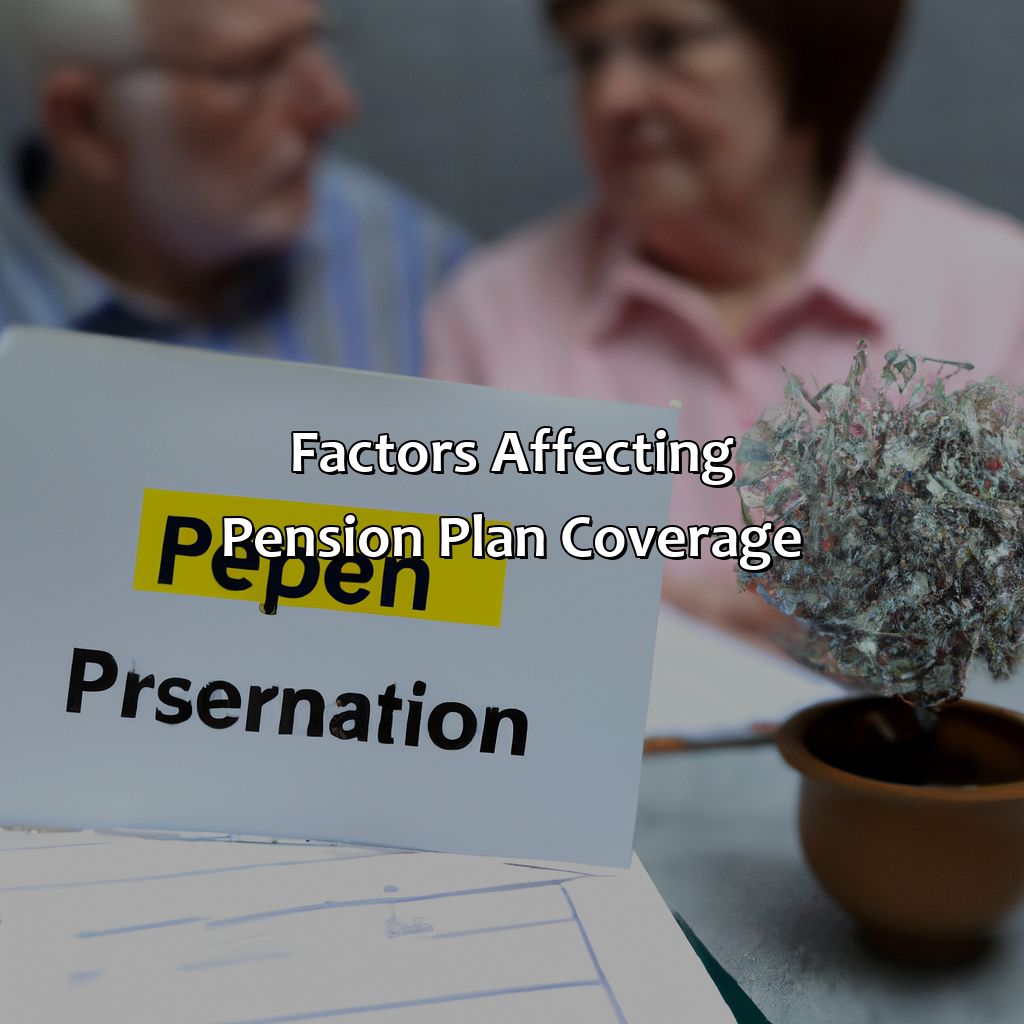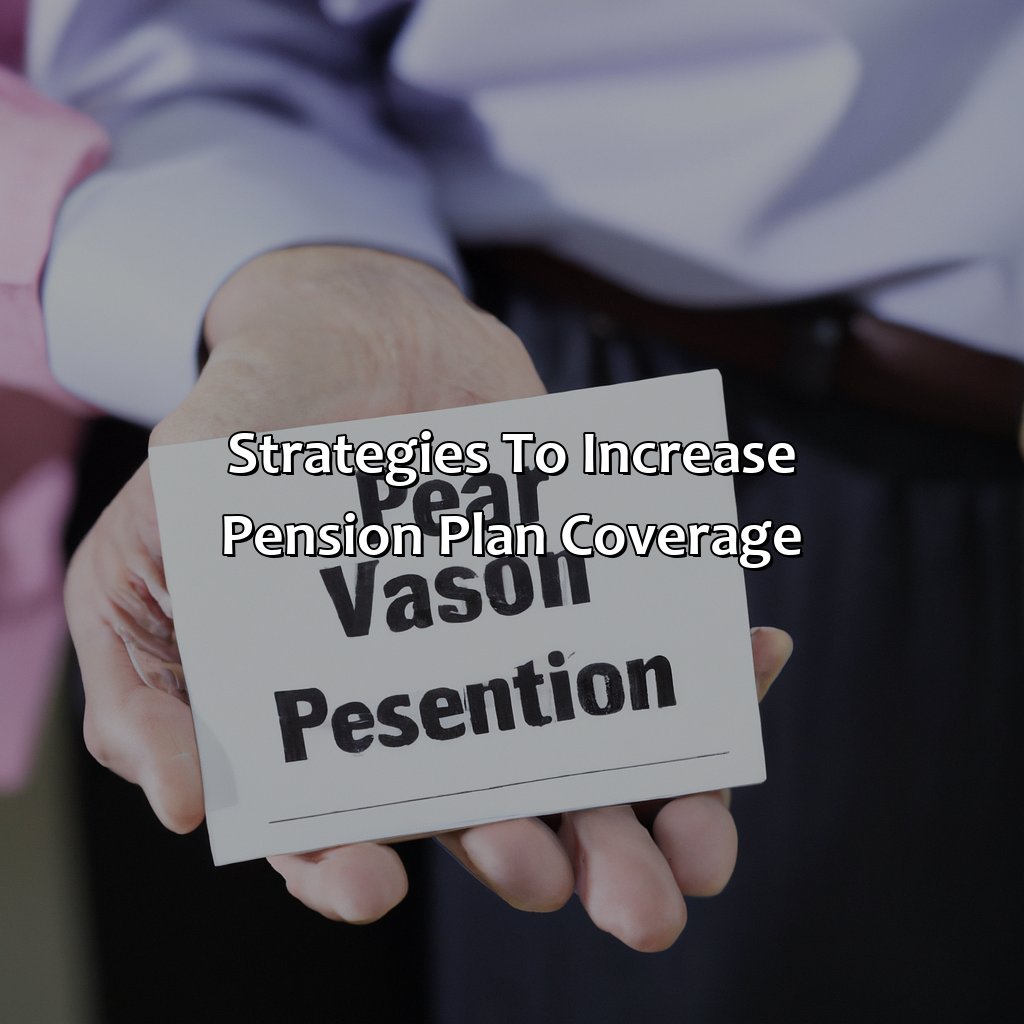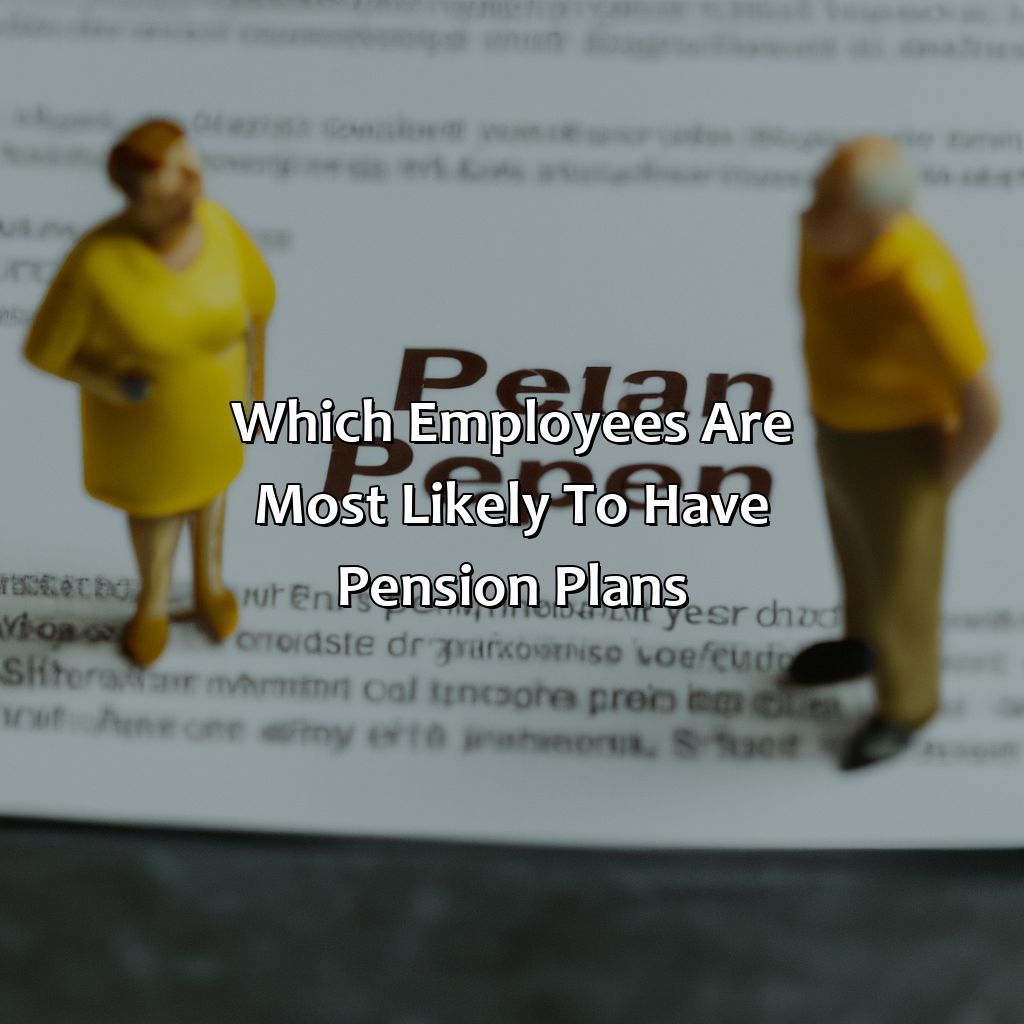Which Employees Are Most Likely To Have Pension Plans?
Key Takeaways:
- Age and income are the most significant factors affecting pension plan coverage, with older and higher income employees more likely to have access to pension plans.
- Education level, gender, industry, and employer type also play a role in pension plan coverage, with those in white-collar jobs and working for larger, more established companies more likely to have access to pension plans.
- Strategies to increase pension plan coverage include shared responsibility plans, automatic enrollment, and pension education and outreach programs, which can help ensure that all employees have access to adequate retirement benefits.
Are you interested in knowing which employees have the greatest access to pension plans? This article will provide insight into which workers are most likely to have one and the reasons why. You will learn why pension plans are so important and their role in ensuring financial security.
Factors affecting pension plan coverage
To grasp the elements that impact pension plan coverage, delve into the section discussing this topic with the heading “Factors Affecting Pension Plan Coverage.” Take a look at the sub-sections: Age, Income, Education Level, Gender, Industry, and Employer Type.
These sub-sections offer solutions to the components that shape pension plan coverage at work.

Image credits: retiregenz.com by David Arnold
Age
As age increases, pension plan coverage becomes more common. Older employees are more likely to have pensions than younger ones due to longer work histories and higher salaries. Factors like retirement plan eligibility, vesting requirements, and company size also play a role in pension coverage.
In addition to age, tenure at a company is another important factor affecting pension coverage. Employees with longer job tenures are more likely to participate in a pension plan, as they have had more time to become eligible for the plan and accrue benefits. Conversely, newer employees may have yet to become eligible or may choose not to participate. If you’re wondering about who manages pension funds, check out our informative article.
It’s essential for employees of all ages to understand the benefits of participating in retirement plans like pensions. Saving early and consistently can help ensure financial security in retirement and prevent missing out on potential earnings from employer contributions. Don’t let retirement savings fall by the wayside – prioritize participation in your company’s available plans today.
Who is eligible for Canada Pension Plan Benefits?
Pension plan coverage depends on income- well that explains why the CEO’s retirement yacht is bigger than their office.
Income
In consideration of financial resources, the standing of an individual’s wealth has shown to affect pension plan coverage. Those in higher wealth tiers receive pension plans more frequently than those in lower tiers. These findings suggest that there is a correlation between income and eligible retirement planning options.
Furthermore, it’s worth exploring how this relationship affects substantial age groups differently. Younger individuals with high salaries receive similar propositions to those older with low incomes, implying an inequality among pension coverage amongst different generations.
Studies have also discovered that racial demographics play a role in pension plan coverage eligibility. Minorities tend to be excluded from matching funds by employers and their companies’ retirement plans – showcasing a large gap within industry standards.
Despite this insight, financial experts understand past examples of socioeconomic privilege and present attempts at reform through governmental policies. In particular, the introduction of Individual Retirement Accounts (IRAs) has positively impacted self-directed retirement savings for underprivileged communities of color.
Seems like the more education you have, the better chance you have at retiring like a boss. Or maybe just retiring, period.
Education level
Individuals with higher levels of educational attainment are more likely to have access to pension plans. This is due to the fact that individuals with higher education tend to work for larger organizations with more resources which offer benefits such as pensions. Additionally, those who pursue advanced degrees may have knowledge and skills that are in high demand and thus can negotiate better benefits packages.
However, education level alone does not determine pension plan coverage. Other factors such as job sector, income level, and employer size also play a role in determining whether or not an individual has access to a pension plan. For example, individuals working in sectors such as healthcare and education are more likely to have access to pensions than those working in retail or hospitality. You can learn more about what percentage of the stock market is owned by pension funds in order to better understand pension plans.
Furthermore, while education level can be indicative of pension plan accessibility, it must be noted that there are still significant disparities within educational groups based on race and gender. Women and people of color are often paid less than their white male counterparts with similar levels of education, making it difficult for them to save enough for retirement.
In the past, pensions were even less accessible than they are now. Prior to the 1970s, most American workers did not have access to any type of retirement plan. The implementation of social security in the 1930s provided some relief, but it was not until the rise of pensions in the mid-twentieth century that many Americans began to secure their retirement years through these types of plans.
Why do men have a higher pension plan coverage? It’s simple, they die earlier.
Gender
The influence of biological sex on pension plan coverage has been a topic of interest among researchers and policy makers. Studies suggest that gender plays a significant role in determining the likelihood of having access to pension plans. Women, on average, have lower pension coverage rates than men due to several factors such as career interruptions and part-time work for caregiving responsibilities.
Furthermore, the gender pay gap also has an impact on pension coverage. Women earn less than men, which results in lower contributions to their retirement savings plans. In addition to these factors, women are more likely to be employed in industries or occupations that offer limited or no retirement benefits.
It is important to note that gender is not the only factor affecting pension plan coverage. Other demographics such as age, education level, job tenure, and income also play a role in determining access to workplace pensions.
One real-life example is Jane, a woman who worked part-time throughout her career while raising children. She had limited access to workplace pensions and saved what she could through individual retirement accounts. Despite her efforts, Jane’s retirement savings fell short of what she needed for a comfortable retirement. This highlights the importance of addressing issues related to pension plan coverage and ensuring that all employees have adequate retirement savings options regardless of gender or other demographic factors.
To know who are not eligible for family pension is important to ensure that everyone has the ability to save for their retirement.
Looks like if you want a pension plan, you better switch careers to the industry that still believes in retirement.
Industry
Industries with High Pension Plan Coverage
Numerous industries in the US provide pension plans to their employees. The availability of these types of benefits may heavily depend on the industry type and size. Industries that regularly offer pension plans have a higher rate of coverage, while smaller companies often face more difficulties in implementing such plans due to financial constraints.
- Financial Services – commonly offers pension plans as their workforce typically demands long-term incentives
- Manufacturing – larger companies in this industry are inclined towards providing such benefits
- Telecommunications – known for offering attractive retirement benefits packages to remain competitive
- Education – most schools with a defined contribution plan benefit from higher employee participation rates
- Government/Public Administration – one-third of public administration employees are enrolled in traditional pensions programs.
- Medical/Healthcare Services – small medical businesses tend to favor 401(k) offerings over traditional pensions; thus, this sector has variable pension coverage rates.
Some research indicates that certain areas of employment, other than industries, play an essential role in determining who is more likely to have access to a pension program.
It is interesting to notice that employees over the age of 50 working for larger establishments have more favorable pension plan options, according to The Center for Retirement Research at Boston College.
US Bureau of Labor Statistics reported that 44% percent of all private-industry workers had access to a defined benefit plan or hybrid defined contribution plan sponsored by their employer. If you are wondering how does a pension fund work, it is a retirement plan where contributions are made by the employer and/or employee and invested, typically providing a fixed income for retirees.
Working for a government agency? Congrats, you’re more likely to have a pension plan than a mob boss with a 401(k).
Employer type
The type of organization has a considerable impact on pension plan coverage. Large corporations are more likely to provide pension plans compared to smaller ones. In fact, medium-sized enterprises frequently lack the necessary resources to offer such benefits. Public sector employers, such as state and local governments, also tend to offer pensions more often.
Additionally, non-profit organizations tend to have lower pension plan coverage rates compared to their for-profit counterparts. This is because many non-profits do not have the financial resources required to fund and manage pension plans.
It’s worth noting that some non-traditional employers may also offer pensions as part of their benefit packages. For example, some universities and hospitals may provide their employees with a defined benefit pension plan.
Individuals who work for large corporations or public sector organizations are more likely to have access to retirement plans than those who work for small or non-profit companies. In one case, a young lawyer chose a job at a large law firm over one at a small firm due in part to the retirement benefits offered by the larger employer.
If you’re wondering how to find your pension information, check out our helpful guide.
Tired of living off Social Security? Here are some tricks to up your chances of actually retiring comfortably.
Strategies to increase pension plan coverage
Want more pension plan coverage? We’ve got strategies! Shared responsibility plans, Automatic enrollment, and Pension education and outreach programs are all great options. This section outlines the different possibilities for pensions plans, as well as their benefits. With these plans, you’re most likely to have a pension plan.

Image credits: retiregenz.com by Yuval Duncun
Shared responsibility plans
Employer-shared Retirement Plans
One effective way to increase pension plan coverage is by implementing employer-shared retirement plans. Employers share the responsibility of contributing to their employees’ retirement plans, which can include a combination of 401(k), pensions, or other defined contribution plans.
These shared plans are especially useful for small businesses that may not have the financial resources to provide conventional pension plans. Both employers and employees benefit from these shared responsibility plans as they promote long-term savings and financial security. If you’re interested in learning more about who Keogh plans were designed to provide pension benefits for, be sure to check out our website.
The role of incentives in Shared Responsibility Plans
An additional way to increase pension plan coverage is through incentives such as tax breaks for both employers and employees. Employers who offer pension benefits receive tax credits or deductions, while employees enjoy reduced tax liability on contributions. These incentives create a win-win situation for both parties, boosting participation rates in shared responsibility plans significantly. Want to know how many pension plans are there in the US?
Automatic enrollment may sound like a fancy way to describe kidnapping, but it’s actually a great way to get employees to save for their future.
Automatic enrollment
Automatic Enrollment in Pension Plans
Employers can increase pension plan coverage among their employees by implementing Automatic Enrollment strategies. Below are a few key points to understand about this strategy:
- Employees are automatically enrolled in the pension plan upon hire unless they choose to opt out.
- Default contributions are set at a minimum level, but the employee can choose to contribute more.
- Inactive or non-participating employees are automatically enrolled at regular intervals.
- Communications and resources are provided to educate employees about how to participate actively in the plan.
- The employer saves administrative costs due to automatic enrollment, which offsets possible losses from default contributions.
- Automatic escalation is another variation of automatic enrollment, where contributions automatically increase over time.
It is important to note that while automatic enrollment is effective in increasing pension plan coverage, it should not be the sole strategy used. Employers should consider offering matching contributions and other incentives for increased participation.
Don’t let your company miss out on the potential benefits of increased pension plan coverage. Implement automatic enrollment and other strategies today for a more secure future for your employees. Because let’s be real, who wouldn’t want a retirement party with more than just a cake and a gold watch?
Pension education and outreach programs
The integration of financial literacy programs into workplace pensions can be an effective tool for increasing participation rates. Such educational programs impart knowledge and resources to employees, empowering them to make informed decisions regarding retirement. Outreach initiatives may also improve coverage by targeting certain demographics, such as women or low-wage workers, who are frequently underrepresented in pension plans. These efforts increase the accessibility and appeal of pension plans by providing tailored information to specific populations.
Offering Pension education and outreach programs can significantly benefit employers and employees alike. However, failing to provide these resources may have detrimental consequences in the long run. Companies that choose not to offer such benefits may find it challenging to attract well-qualified candidates who prioritize retirement security when job hunting. Find out which of the following IRAs provides a pension for employees to make an informed decision.
Additionally, employees without access to this education risk being unprepared for retirement and potentially facing financial insecurity in their later years. Therefore, ensuring that all employees have access to adequate support is essential for cultivating a stable and engaged workforce.
Five Facts About Which Employees Are Most Likely to Have Pension Plans:
- ✅ Government employees are more likely to have pension plans compared to private sector employees. (Source: Pew Research Center)
- ✅ Workers in the financial sector tend to have better pension options, including defined benefit plans. (Source: Investopedia)
- ✅ Unionized employees are more likely to have pension plans as they often negotiate for better retirement benefits. (Source: National Institute on Retirement Security)
- ✅ Older employees are more likely to have pension plans as they have had longer to accumulate benefits. (Source: U.S. Bureau of Labor Statistics)
- ✅ Employees in high-paying industries, such as healthcare and technology, are more likely to have access to pensions. (Source: Forbes)
FAQs about Which Employees Are Most Likely To Have Pension Plans?
Which employees are most likely to have pension plans?
Employees who work in the public sector, such as government employees and teachers, are more likely to have pension plans than those who work in the private sector.
Do all public sector employees have pension plans?
No, not all public sector employees have pension plans. It can vary depending on the state, institution or organization they work for.
What about private sector employees?
While some private sector employees may have pension plans, it is less common than in the public sector. Instead, many companies offer 401(k) plans or other retirement savings options.
What types of jobs in the private sector are more likely to have pension plans?
Jobs in industries such as finance, healthcare and engineering are more likely to come with pension plans in the private sector.
Is there a certain age or tenure requirement to be eligible for a pension plan?
It depends on the company or organization, but often employees must work for a certain number of years before becoming eligible for a pension plan. The age requirement may also vary.
What should employees do if their company doesn’t offer a pension plan?
Employees can look into opening an Individual Retirement Account (IRA) or other retirement savings options to supplement their income during retirement.
